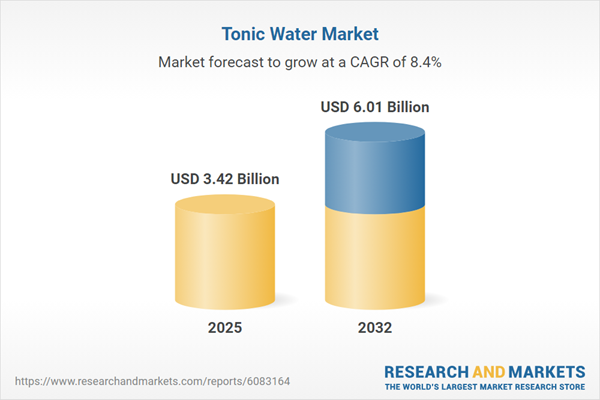Speak directly to the analyst to clarify any post sales queries you may have.
The tonic water market is rapidly reshaping as senior leaders respond to shifting consumer preferences for premium, wellness-driven beverages and experimental flavors. Effective strategies require actionable insights to navigate evolving dynamics and optimize positioning within this competitive sector.
Market Snapshot: Tonic Water Market Size and Growth Overview
The tonic water market grew from USD 3.16 billion in 2024 to USD 3.42 billion in 2025, with a projected CAGR of 8.36% aiming toward USD 6.01 billion by 2032. Intensified interest in healthier, low-sugar, and botanically inspired drinks is generating steady momentum. Brands leveraging product innovation and agile responses to consumer behaviors are solidifying their market positions. Strategic adoption of new technologies and distribution models strongly influences which companies can capture the greatest value and manage market complexity.
Tonic Water Market Scope & Segmentation
This report delivers a structured overview for decision-makers, outlining sector drivers and actionable segmentation to enhance planning and differentiation:
- Product Types: Includes diet tonic water, organic tonic water, premium flavored varieties with both artificial and natural flavorings (such as botanical, citrus, and fruit), alongside classic tonic water options.
- Distribution Channels: Covers off trade such as convenience stores, online retail, e-commerce, manufacturer portals, and supermarkets, as well as on trade—bars, cocktail lounges, sports bars, nightclubs, restaurants, and dining establishments of all formats.
- Packaging Types: Encompasses aluminum cans, glass bottles, and PET bottles, each reflecting shifting consumer attitudes toward convenience and ecological responsibility.
- Flavor Profiles: Ranges from citrus and cucumber to elderflower, herbal, and standard tonic, responding to evolving palates and stimulating innovation in product portfolios.
- End Users: Serves commercial segments spanning entertainment venues, food service, hospitality, and the household market with differentiated needs and usage patterns.
- Regional Coverage: Analyzes the Americas, Europe, Middle East & Africa, and Asia-Pacific, highlighting markets like the United States, United Kingdom, Germany, Japan, and China, where regional and regulatory factors drive consumption diversity.
- Prominent Companies: Examines competitive strategies by Britvic PLC, Fentimans Ltd, Fever-Tree Drinks PLC, Franklin & Sons Ltd, Keurig Dr Pepper Inc., PepsiCo, Q Drinks LLC, Suntory Beverage & Food Limited, The Coca-Cola Company, and Thomas Henry GmbH & Co. KG.
Key Takeaways: Strategic Insights for Leaders
- Expanding consumer interest in health-centric, low-sugar, and organic tonic water is accelerating new product segments and driving redefined brand value propositions.
- Premiumization is widening competition as brands launch botanically infused variants with increased transparency about sourcing and production methods.
- Digital-first sales approaches, such as direct-to-consumer and subscription services, are unlocking new access to consumer data and enabling more precise marketing strategies.
- Broad adoption of sustainable packaging and responsible ingredient sourcing is enhancing brand reputations among both corporate and values-driven buyers.
- Advances in infusion, microdistillation, and related technologies are enabling consistent delivery of complex, creative flavor profiles and supporting rapid product development cycles.
- Strategic alliances within the supply chain, from ingredient partnerships to collaborations with mixologists, expand distribution and bolster adaptability in a shifting market landscape.
Tariff Impact: Navigating Policy-Driven Change
Recent U.S. tariffs on select bitter botanicals and packaging components are prompting supply chain realignment. Importers are widening supplier networks, while domestic producers strengthen local sourcing and refine procurement strategies. Smaller craft brands differentiate with local botanicals and emphasize compliance adjustments. Pricing strategies and promotional initiatives are being adapted to balance volume stability with profitability amid these regulatory changes.
Research Methodology & Data Sources
Insights are grounded in comprehensive desk research using trade journals, regulatory filings, and industry publications. Targeted interviews with executive-level stakeholders and structured surveys of distributors and end-users provided depth. All data underwent triangulation and peer review for validation and accuracy.
Why This Report Matters: Actionable Benefits for Decision-Makers
- Empowers leadership with segment- and region-specific analysis to inform market entry, expansion, and repositioning strategies.
- Equips organizations to anticipate regulatory, supply chain, and evolving consumer developments with confidence.
- Provides practical recommendations aligned with emerging trends and risk factors in the global tonic water market.
Conclusion
This report provides leaders with the targeted insights necessary for proactive strategy, effective product innovation, and sustained competitive advantage as market dynamics evolve.
Table of Contents
3. Executive Summary
4. Market Overview
7. Cumulative Impact of Artificial Intelligence 2025
Companies Mentioned
The companies profiled in this Tonic Water market report include:- Britvic PLC
- Fentimans Ltd
- Fever-Tree Drinks PLC
- Franklin & Sons Ltd
- Keurig Dr Pepper Inc.
- PepsiCo, Inc.
- Q Drinks LLC
- Suntory Beverage & Food Limited
- The Coca-Cola Company
- Thomas Henry GmbH & Co. KG
Table Information
| Report Attribute | Details |
|---|---|
| No. of Pages | 196 |
| Published | November 2025 |
| Forecast Period | 2025 - 2032 |
| Estimated Market Value ( USD | $ 3.42 Billion |
| Forecasted Market Value ( USD | $ 6.01 Billion |
| Compound Annual Growth Rate | 8.3% |
| Regions Covered | Global |
| No. of Companies Mentioned | 11 |









